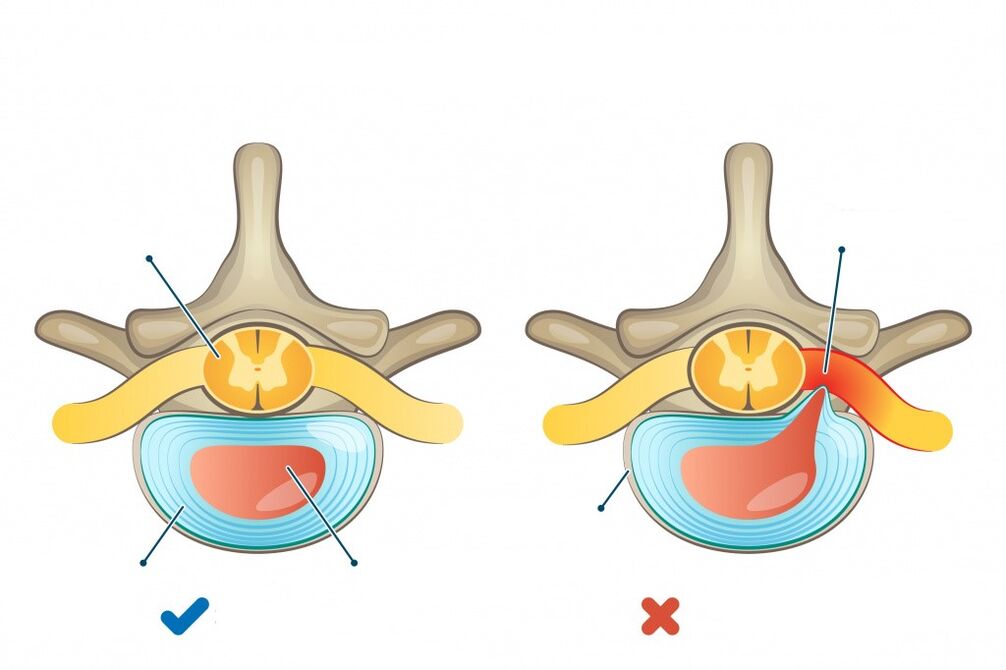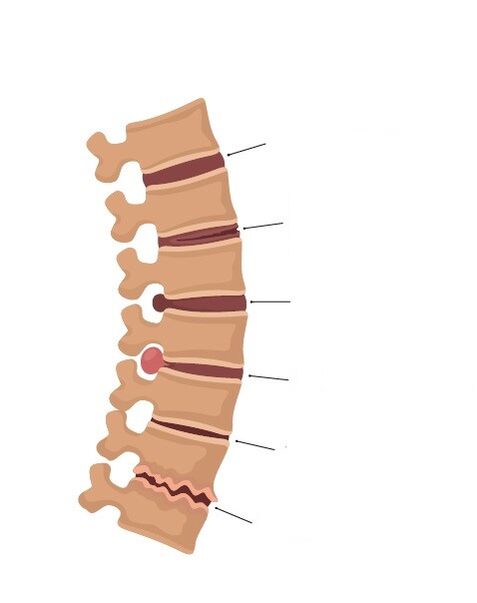The spine includes the cervical, thoracic, lumbosacral parts and consists of 33-34 vertebrae located on top of each other and connected into a single chain.To distribute the load on the spinal column during daily physical activity and when the body is in an upright position, the spine has a physiological (normal) curve.Two forward convex curves in the cervical and lumbar regions (Lordosis) and two backward convex curves in the thoracic and sacral regions (kyphosis).Between the vertebrae there is an intervertebral disc - cartilage, which performs the function of shock absorbers and consists of the nucleus pulposus and a fibrous ring around it.

Osteochondrosis of the spine is a chronic disease characterized by the development of degenerative-dystrophic changes in the intervertebral disc with subsequent involvement of adjacent vertebrae and surrounding tissues in the process.
Currently, doctors more often use the broader term "dorsopathy" to refer to pain in the back and neck, sometimes replacing the concept of "osteochondrosis" with it.Dorsopathy includes pain in the neck (cervicalgia), neck and head (cervicocranialgia), neck and shoulders (cervicobrachialgia), chest pain (thoracalgia), lower back pain (lumbodynia), lower back pain radiating to the legs (lumboischialgia).
Causes of osteochondrosis of the spine
Until now, there is no accurate data on the causes of degenerative changes in the spine.There are several theories that consider various factors: involution (involution - reverse development, retrograde movement), mechanical, immune, hormonal, dysmetabolic (metabolic), vascular, infectious, functional and hereditary.The most common is the theory that involves, according to local (local) premature aging of cartilage and bone occurs as a result of previous mechanical damage or inflammation.According to this theory, the development of degenerative changes in the spine is genetically predetermined, and the occurrence of diseases with corresponding clinical manifestations is caused by the influence of various endogenous (internal) and exogenous (external) factors.
The possibility of osteochondrosis increases with age, with the presence of excess body weight, an inactive lifestyle and poor physical fitness, on the one hand, and physical exposure and heavy physical vibration, on the other.
The load on the spine increases in proportion to the increase in body weight, so overweight people experience loads even in conditions of moderate activity;This condition is exacerbated by a tendency to be physically inactive due to poor tolerance to physical activity.
Psycho-emotional stress, coupled with an inactive lifestyle, causes tension in individual muscle groups, changes in muscle tone, and movement patterns - posture, gait.The development of scoliosis - lateral curvature of the spine, pathological kyphosis and lordosis (aggravation of the physiological curve) also contribute to the deformation of the intervertebral disc.
Classification of diseases

By localization:
- cervical spine osteochondrosis;
- osteochondrosis of the thoracic spine;
- Osteochondrosis of the lumbar and sacral spine.
According to the phase of the disease:
- exacerbation (maximum number of clinical manifestations);
- remission (absence of clinical manifestations).
Depending on the pathologically affected formation, the affected structures of the spine are distinguished:
- Reflex syndrome - Contaminated muscle reflex tension, or muscle disorders - tonic (muscle spasm), vascular, vegetative, dystrophic - develops when pain receptors are shocked.
- Compression syndromes often develop against the background of protrusion (bulging, protrusion of the intervertebral disc beyond the spinal column without compromising the integrity of the fibrous ring) or disc herniation due to compression of a nerve root, spinal cord or vessel (radiculopathy, neuropathy, myelopathy, radiculoischemic syndrome are distinguished accordingly).
Depending on the stage of development of the process, there are:
- The stage of the intradiscal pathological process (chondrosis).During this period, intradiscal movement of the nucleus pulposus occurs.The nucleus pulposus penetrates its outer fibers through a crack in the fibrous ring.As a result, nerve endings are irritated and pain develops.
- The degree of instability, or loss of fixation ability of the affected disc, when the overlying vertebra is displaced in relation to the underlying one.During this period, instability syndrome, reflexes and even compression syndrome can form.
- The degree of formation of a herniated intervertebral disc is caused by a violation of the integrity of the fibrous ring, which can compress adjacent neurovascular formations, including spinal nerve roots.
- The degree of fibrosis of the intervertebral disc and the formation of marginal osteochondral growth of the vertebral bodies, resulting in the immobility of the vertebrae and increased compensation in their area of support for the deformed disc.In some cases, this bony growth, such as disc herniation, can compress adjacent neurovascular formations.
Symptoms of osteochondrosis

Symptoms of osteochondrosis depend on the area of damage to the spine and the degree of changes that occur in it, and the function of internal organs may be affected.
Osteochondrosis of the cervical spine is characterized by pain in the neck, which increases during movement, radiates to the arm and is accompanied by numbness of the fingers.
Complaints of headache in the occipital region, dizziness, tinnitus, dark eyes or flashing spots before the eyes are possible.
When the thoracic spine is affected, the patient may experience pain in the heart area, in the interscapular region, lasting a long time, aching or pressing, rather sharp, piercing, sharp.
They can occur or intensify with deep breathing, when bending and turning the body, when raising the arms, sneezing, coughing.There may be numbness in the skin on the chest, abdomen and back.
With osteochondrosis of the lumbosacral region, patients note stiffness of movement, pain in the lower back, which can radiate to one or both legs, increasing when bending, turning the body, walking, lifting heavy objects.
Possible Vegetative Disorders: Lack of feet at a comfortable temperature for the whole body, paleness of the skin of the feet.There is numbness, paresthesia (pins and needles sensation) of the skin of the legs and buttocks.
Disease diagnosis
Instrumental diagnostics involves radiography of the spine to exclude traumatic injuries, congenital structural anomalies, and identify bony growths.The study is also carried out with functional tests - taking pictures during flexion and extension in the cervical and lumbar regions to exclude pathological displacement of the vertebrae relative to each other.






















